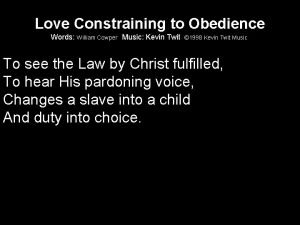Constraining Aerosol Properties Using H 2 O Retrievals

- Slides: 1

Constraining Aerosol Properties Using H 2 O Retrievals from the California Laboratory for Atmospheric Remote Sensing (CLARS) Zhao-Cheng Zeng 1, 3, Qiong Zhang 1, Vijay Natraj 2, Run-Lie Shia 1, Stanley P. Sander 2, Paul O. Wennberg 1, and Yuk L. Yung 1 1 Division of Geological and Planetary Sciences, California Institute of Technology, Pasadena, USA; 2 Jet Propulsion Laboratory, California Institute of Technology, Pasadena, USA; 3 ISEIS, The Chinese University of Hong Kong, Hong Kong. Correlation between H 2 O retrievals and Aerosol Optical Depth Abstract H 2 O has absorption features across the electromagnetic spectrum, from the ultraviolet to the infrared. The California Laboratory for Atmospheric Remote Sensing (CLARS) on the top of Mt Wilson, California, offers continuous highresolution spectral measurements from 4000 to 8000 cm-1. We retrieve H 2 O slant column densities (SCDs) at different wavelengths using CLARS data. In particular, we compare retrievals from the spectralon, which is above the planetary boundary layer and relatively immune to aerosol scattering, with those from West Pasadena, a location in the Los Angeles basin that is influenced by aerosol scattering. SCD retrievals for West Pasadena show significantly larger variance across different wavelengths. The retrieval error in West Pasadena is much larger than can be attributed to spectroscopic uncertainties, and reflects the wavelength dependence of aerosol scattering. (c-1) (c-3) (a-1) (a-3) (a-2) (a-4) (b-1) (b-3) (d-1) (d-3) (b-2) (b-4) (d-2) (d-4) (c-2) CLARS and its H 2 O measurements Direct beam SVO mode CLARS Mt. Wilson Reflected sunlight LABS mode (a) AERONET PBL height LA basin Figure 1. Schematic figure of CLARS measurement geometries, and the AERONET site in Caltech. CLARS has two modes of operation, including Los Angeles Basin Survey (LABS) mode using reflected sunlight from the LA basin that undergoes absorption and scattering by trace gases and aerosols below the CLARS site, and Spectralon Viewing Observation (SVO) mode using reflected sunlight from a locally positioned Spectralon plate that samples the solar beam above CLARS and makes measurements in the free troposphere above the Mt. Wilson. (b) Figure 1. Correlations between CLARS H 2 O SCD retrievals from multiple bands and AERONET Aerosol Optical Depth (AOD) in caltech are show for 4 chosen days, (a) 01 March 2013, (b) 19 April 2013, (c) 15 July 2013, and (d) 28 September 2013. The subplots are (1) the fraction of difference calculated from original H 2 O SCD retrievals by subtracting the mean and then divided by the mean; (2) the time series of AOD in 7 bands from AERONET in Caltech; (3) scatter plot between the standard deviation of the fraction of difference, as shown in (1), and the AOD in seven bands, as shown in (2); and (4) the same plot with (3) but for AOD less than 0. 1. q The correlations are different in different days, a positive correlation can be seen for Sept. 28, while a positive correlation for July 15, and bi-model for March 01 and April 19. q The different correlations may due to different aerosol properties, but can also be affected by other factors, such as change of planetary boundary layer height, the change of aerosol phase function and surface reflection with varying solar zenith angle. Figure 2. Variations of the CLARS H 2 O SCD measurements in West Pasadena from the morning to the afternoon for (a) SVO mode and (b) LABS mode. q Since the effect of aerosol in the upper troposphere is negligible, the H 2 O SCD retrievals are almost the same, as shown in (a). However, since aerosol scattering has wavelength dependence, different variation of H 2 O SCDs in the upper troposphere and boundary layer, as shown in (b); q We get the fraction of difference between the H 2 O retrieval by subtract the mean from the retrievals and then divided by the mean. And the analyze the variation of H 2 O SCD with AERONET AOD data in caltech (close to the West Pasadena), as shown in next session. References: Fu et al. , AMT, 2014; Holben et al. , Remote Sens. Environ. , 1998; Zhang et al. , JGR, 2015 Conclusions and future works q We demonstrate that effect of aerosol scattering in the boundary layer on the H 2 O retrievals, and the correlation between the difference of H 2 O retrievals from multiple bands and observed aerosol optical depth. q Analyze the effect of aerosol scattering on different bands, and find out the minimal bands combination that can mostly represent the difference of H 2 O retrievals. q 2 S-RT model to simulate the effects, and analyze the magnitude of impact from all the factors. More data are to be incorporated.

